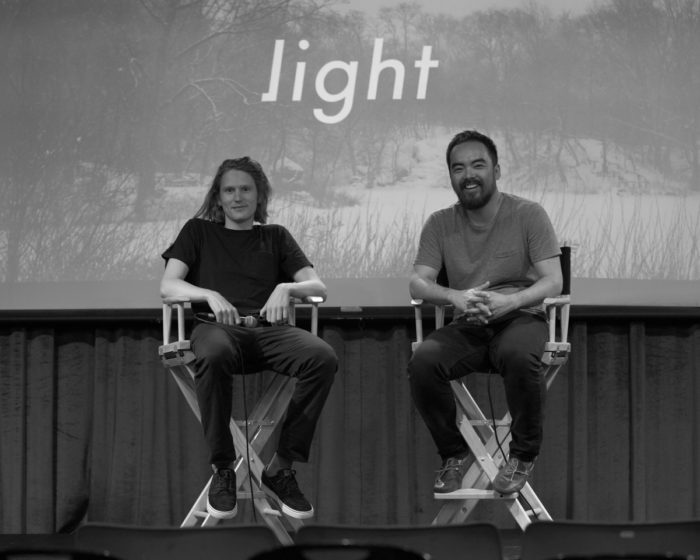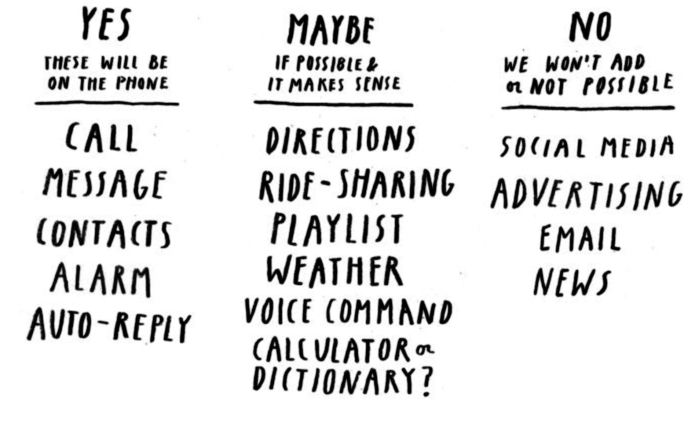The most radical U-turn in phone technology was inspired one evening a few years ago when Joe Hollier went out to a nice dinner with his girlfriend. Hollier, a graphic designer, never considered himself one of those smartphone addicts. In fact, he’d often abandon his device for upwards of ten hours at a time to paint or to go skateboarding, a “freeing pastime,” as he calls it.
Yet that night in the restaurant, when his girlfriend went to the restroom, Hollier says he fired up his phone and opened an email from a client who’d filed a work request. It wasn’t something Hollier needed to address until the next day, but he began to concern himself with the looming task. Hollier felt “mentally thrown off” and “frustrated.”
“It’s like, Why did I check my email? I’m out to dinner!” Hollier remembers thinking.

Company founders Joe Hollier, the design maven, and Kaiwei Tang, the CEO
Then, in the fall of 2014, he enrolled in a Google-sponsored program called 30 Weeks, which promised to transform designers into startup entrepreneurs by introducing them to new people and ideas. Hollier met an engineer, Kaiwei Tang, who’d recently quit his job building cellphones after about ten years of working for the likes of Nokia and Motorola. “I just realized … everyone’s making different kinds of smartphones,” Tang, 37, says, “[with a] bigger screen, different processor, adding this tiny feature, and it got to a point where I thought, Why are we doing this? And I never got an answer.”
Hollier and Tang clicked immediately. “He’s a weird kid,” Tang says of Hollier, a lanky 27 year old whose appearance and slight social awkwardness call to mind the actor Crispin Glover. “He’s a great graphic designer. I love his work.”
During the 30 Weeks program, participants were instructed to come up with new smartphone apps, which irked Hollier so much he considered dropping out. He told Tang, somewhat jokingly, “If I were going to make a smartphone app it would be to get off the phone.” Up to that point Tang thought he’d never build a phone again, but his creative instinct took over.
“It was like a couple of booms went off,” Hollier explains. Tang asked him, “Well, what would that look like? What if we had a phone to get away from our phone?”
They reminisced about the early days of dial-up internet, when you left the internet behind simply by walking away from your computer. The pair wondered, according to Hollier, “What if we could bring back that awareness of when you’re on or off?”

The company is still considering which features will be included in the Light Phone 2–and which are off the table
In an experiment, Hollier and Tang bought about a half dozen old-school flip phones and dispensed them to friends, ordering their guinea-pig pals to spend one weekend using only those devices. “There’s this initial anxiety that happens,” Hollier found out. “It’s a lot more powerful than you might expect [but] once you get over that, you end up being able to relax and get lost in daydreaming, or a conversation with a friend or even a stranger. We saw it was a really positive experience.” Hollier says he and Tang learned that “the value wasn’t in whatever we were making, it was about not having a smartphone.”
They formed a company called Light, now based in New Lab in the Brooklyn Navy Yard, and developed the first iteration of the Light Phone. Hollier conceptualized its look and feel, while Tang worked with designers to build it. They described it as a “credit-card-sized cell phone designed to be used as little as possible. The Light Phone is your phone away from phone.” All white, with a matte glass covering the LED keypad display, the only thing the Light Phone could do is display the time of day and make phone calls, after pairing with a smartphone.
The founders launched a Kickstarter campaign in May 2015 to raise enough money to start production. They pulled in just over $415,000 from backers in more than 50 countries. To Hollier’s surprise, the backers crossed all social demographics. “To see older CEOs be like, ‘I bring my smartphone to my desk and I can’t get anything done,’ to Bible Belt families who say, ‘We want this to be our Sunday family phone’ was just something I couldn’t even foresee,” says Hollier.
The Kickstarter ploy also drew vast media attention. “Hate Your Phone? This Kickstarter is For You,” read one Time headline, while NBC News offered, “Light Phone Lets You Leave Your Real Phone at Home Yet Stay Connected.” Tang parlayed the press into a meeting with executives from the Taiwan-based Foxconn Technology Group, the world’s largest contract electronics manufacturer.

Part of the company’s marketing message is to lampoon smartphone addiction and its effect on our lives
“I do this pitch about Light Phone and afterwards one of the executives basically said, ‘I need it right now because the smartphone is ruining my life,’” Tang recounts. Foxconn, which assembles iPhones, has since become Light’s manufacturing partner and one of the company’s primary investors. Foxconn, alongside several private financiers, Hollier says, invested more than $3.5 million in Light, helping them to manufacture and ship the first Light Phone in January 2017. Manufacturing costs rose to unexpected heights, as they’re wont to do, during the phone’s making, so the retail price was set at $150, or $50 more than Kickstarter backers paid for their phones in advance. Since last year they’ve sold 10,500 Light Phones, with a reservation backlog of 5,000 buyers, says Hollier.
“I am excited about what we’re creating,” says Tang. “I’m even more excited about the movement, right now.” Indeed, a trend toward simpler phones, at least among a subset of users, is surfacing in the mainstream. “A simple flip phone is the new protest statement,” said the Seattle Times. “Now might be the ripest moment in a decade for some serious low-end disruption,” reported the Wall Street Journal. The company has been successfully mischievous in its marketing materials too, even producing a series of video shorts called The Smartphone Series, which gently mocks society’s addiction to its devices.
Among the feedback the company has received, say the founders, they’re most surprised by inquiries from teenagers. “I’m not giving enough credit to our next generation,” Tang says. “They’re actually awake now; they can see how technology is attacking them.” Their parents, too, may appreciate its self-limiting qualities. ABC News recently called the Light Phone a perfect first phone for children of parents who don’t want their youngsters tooling around on social media platforms. Tang and Hollier hadn’t even thought of that during its initial development; Hollier describes one other context for his invention by calling it a “bedside phone,” there for emergencies but not idle browsing.
For their next act, Light is planning a model that’s not quite so extreme in its simplicity. In March they announced the concept of the Light Phone 2, with a corresponding Indiegogo campaign that has raised more than $1.5 million. This phone will have a more reliable 4G antenna for calls, but users will also be able to send and receive text messages. There will be an alarm clock and “other essential tools.” Hollier and Tang say the conversation about what smartphone functions are actually useful versus those that might cause digital addiction has been interesting. Are maps a tool? Uber? How about podcast and music apps? They’re trying to figure all that out in time for an expected shipping date in April 2019.
Such contemplations are often explored in the sprawling community office space at New Lab. Tang, who lives in Williamsburg, and Hollier, a longtime Bushwick resident, love being a part of the emergence of a tech hub in Brooklyn and in New York City at large. “We never really saw ourselves as moving to San Francisco,” Hollier says. “There’s a design sense that is in New York that maybe is not as strong there,” he says. As Tang puts it, the company is “proud to be a Brooklyn-based tech brand, creating alternative options.”
“This whole movement, this phenomenon is going to intensify this year,” says Tang, who saw an even greater outbreak of cellphone addiction while pitching Light Phone in Asia. “It’s time to fight back.”